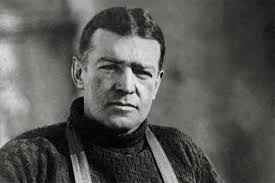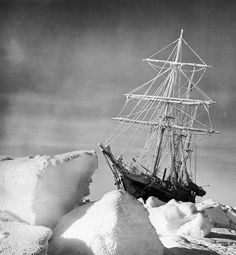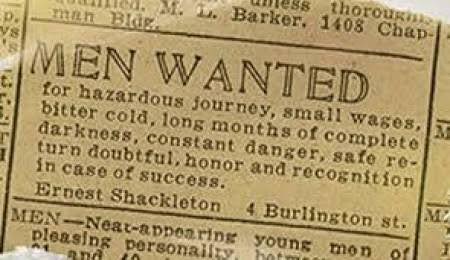An outstanding Antarctic expedition leader

THE DISCOVERY EXPEDITION
Officially known as the British Antarctic Expedition, these early Antarctic voyages were unofficially known by the name of the ships that carried them. In this case the ship was the ‘Discovery’.
The Discovery expedition was the first British government funded expedition to Antarctica and it made important discoveries for science and about the Antarctic continent, while also reaching the furthest point south at that time. It launched the polar careers of Scott and Shackleton and led to fame for Scott. Shackleton became ill from scurvy and was sent home on a relief ship. It was a rather disappointing start to his Antarctic career but he would return with his own expeditions later and leave an indelible mark on the history of Antarctic exploration.
THE NIMROD EXPEDITION
The Nimrod was Shackleton’s ship that he used for the The British Antarctic Expedition 1907–09.
His expedition achieved a number of firsts, including the first to climb Mount Erebus, first to reach the Magnetic South Pole and the furthest point south reached at that time, only 156 km short of the Geographic South Pole.
To house his shore party of 14 men at Cape Royds, Shackleton had brought with him a specially designed prefabricated hut made by Humphreys Limited of Knightsbridge, London. It was a rather spacious hut though perhaps not so much when occupied by fourteen men.
The hut performed admirably in the extreme cold and against the ferocious winds. The fact that the main part of the hut is still standing over 100 years after its completion is a testimony to the builders and designers.

SHACKLETON’S HEROIC ATTEMPT TO REACH THE SOUTH POLE
On the 3rd of November, 1908, Ernest Shackleton set out from a small hut in Antarctica with three other men, four sledges and ponies, and 1.2 tonnes of food and equipment, bent on reaching the South Pole.
He left behind a sealed letter to his wife Emily “…if I did wrong in going away from you and our children that it was not just selfishness…your husband will have died on one of the few great things left to be done.’
They encountered, difficult snow conditions, blizzards and the ponies falling into crevasses. Twenty days in they shot the first pony, Chinaman, who had become debilitated. It was always going to be a one-way trip for the ponies, unfortunately. They stored some of the meat and carried the rest to consume.
In Scott’s Discovery expedition of 1901-04, Scott had reached the furthest point south ever achieved by humans. On November 26th, Shackleton and his team passed Scott’s furthest point, and in celebration shared a 4-oz bottle of orange curaçao, a Caribbean liqueur.
They continued on. The pony, Grisi, was the next to be shot when her condition deteriorated. A few days later Quan became weak and shaky. and also was put down.
With great luck they found a path through the Trans-Antarctic Mountains and reached the Beardmore Glacier, 200 km long and the path to the South Pole.
Travelling through an area of crevasses, Socks the final pony, fell into a crevasse and was lost, almost taking one of the team with her. They continued on and on Christmas Day were on the edge of the Polar plateau at a height of 2896 metres (9500 feet).
The team were suffering from altitude induced headaches, shortness of breath, low body temperatures and general weakness.
On New Year’s Day they had nine days food left for their outward journey but it would take 14 days to reach the South Pole. Shackleton knew they would never make it so he changed their goal to reach within 100 miles of the Pole.
On the 9th of January, they made a last dash, leaving their tent behind and marched hard for 5 hours. By 9am they were 97 miles (156km) from the pole, the record for the furthest South travel of any human. They raised the Union Jack, took a photo and headed back (a tale in itself)

Further hardships followed, Shackleton and another team member had to leave the other two and continue on to get a rescue party. In the end they all made it.
They had walked 2700 km through the toughest country and weather for 120 days. It was a tale of hardship and great bravery at the end of the world and though he fell short of the Pole it was an outstanding achievement.
For this and other successes of this expedition, Shackleton was knighted on his return to England.
Shackleton left behind a fully stocked hut at Cape Royds (Shackleton’s Hut) when the expedition returned to England and most of the stores are still there, as is the fully restored hut. Upon leaving Antarctica to go back home, Shackleton wrote:
“We all turned out to give three cheers and to take a last look at the place where we had spent so many happy days. The hut was not exactly a palatial residence … but, on the other hand, it had been our home for a year that would always live in our memories…. We watched the little hut fade away in the distance with feelings almost of sadness, and there were few men aboard who did not cherish a hope that some day they would once more live strenuous days under the shadow of mighty Erebus.”
THE ENDURANCE EXPEDITION

One of the great survival epics of all time was Sir Ernest Shackleton’s Endurance Expedition of 1914 (the Imperial Trans-Antarctic Expedition). Since the South Pole had finally been reached a few years earlier the only significant milestone left was to cross the Antarctic continent. Shackleton decided to make the attempt. He sent one party by ship to the other side of Antarctica to lay depots of stores and his plan was to set out from the other side and then use those depots to complete the crossing. Unfortunately, he never even reached the Antarctic continent.
The Endurance was a specially built polar ship and considered to be one of the strongest wooden ships ever built. It was named after Shackleton’sfamily motto:
“Fortitudine vincimus” (By endurance we conquer).
Unfortunately, it was designed for breaking through sea ice, not for being trapped in ice. Some of the polar ships were built with a hull shape that allowed them to rise up if being crushed by pack ice. Endurance did not have that hull shape.
Endurance became trapped in the ice and after almost a year in its grip, even her strongly built hull was crushed and she sank. The crew would spend seven more weeks on the ice before it started to break up.
They then used the ship’s three lifeboats to reach Elephant Island and set up a camp using two of the upturned boats as shelter.
From there Shackleton and five crew set off in the remaining boat for South Georgia, another epic journey, but arrived on the opposite side of the island from the whaling station. Shackleton and two men headed overland and eventually found the station.
It would take three months and three attempts before Shackleton could rescue the men on Elephant Island but eventually he was successful.
The expedition to cross Antarctica was an epic failure but the survival story was an epic success and has become legendary.

This advertisement was supposedly placed by Ernest Shackleton for his Imperial Trans-Antarctic Expedition of 1914-1917. Though the advertisement is likely to be a myth and no-one has ever found an example of it, Shackleton did receive over 5000 applications for his expedition through newspaper coverage. It’s a great advertisement though, and reflects the adventurous perception and danger of Antarctic exploration at the time

